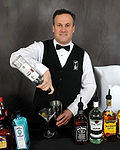This article needs additional citations for verification .(October 2013) |

A whisk is a cooking utensil which can be used to blend ingredients smooth or to incorporate air into a mixture, in a process known as whisking or whipping . Most whisks consist of a long, narrow handle with a series of wire loops joined at the end. The loops can have different shapes depending on a whisk's intended functions. The wires are usually metal, but some are plastic for use with nonstick cookware. Whisks are also made from bamboo.
Contents
Whisks are commonly used to whip egg whites into a firm foam to make meringue, or to whip cream into whipped cream.








